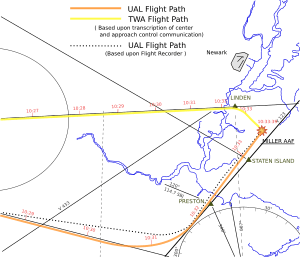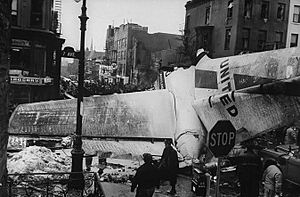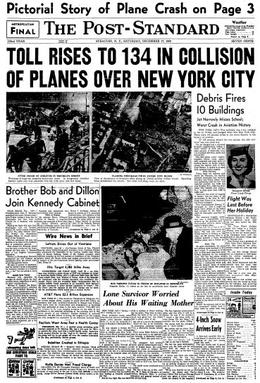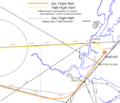1960 New York mid-air collision facts for kids
| Accident summary | |
|---|---|
| Date | December 16, 1960 |
| Summary | Mid-air collision |
| Place | About a mile west of Miller Field 40°34′07″N 74°07′19″W / 40.56861°N 74.12194°W |
| Total injuries (non-fatal) | 0 |
| Total fatalities | 134 |
| Total survivors | 0 |
| First aircraft | |
 The tail assembly of N8013U, the Douglas DC-8-11 involved in the collision |
|
| Type | Douglas DC-8-11 |
| Name | Mainliner Will Rogers |
| Airline/user | United Airlines |
| Registration | N8013U |
| Flew from | Chicago-O'Hare International Airport (ORD/KORD), IL |
| Flying to | Idlewild Airport (IDL/KIDL)(Now John F. Kennedy International Airport), New York City |
| Passengers | 77 |
| Crew | 7 |
| Injuries (non-fatal) | 0 (1 initially) |
| Fatalities | 84 (83 initially) |
| Survivors | 0 (1 initially) |
| Second aircraft | |
N6907C, the Lockheed L-1049A Super Constellation involved. |
|
| Type | Lockheed L-1049A Super Constellation |
| Name | Star of Sicily |
| Airline/user | Trans World Airlines |
| Registration | N6907C |
| Flew from | Dayton International Airport (DAY/KDAY), Dayton, Ohio |
| Stopover | Port Columbus International Airport (CMH/KCMH), Ohio |
| Flying to | LaGuardia Airport KLGA New York |
| Passengers | 39 |
| Crew | 5 |
| Fatalities | 44 |
| Survivors | 0 |
On Friday, December 16, 1960, two airplanes crashed in New York City. A United Airlines Douglas DC-8 jet was flying towards Idlewild Airport (now John F. Kennedy International Airport). At the same time, a TWA Lockheed L-1049 Super Constellation was flying towards LaGuardia Airport.
The two planes collided in the air. The Constellation crashed on Miller Field in Staten Island. The DC-8 crashed in Park Slope, Brooklyn. All 128 people on both planes died. Six people on the ground also lost their lives. This accident was the deadliest aviation disaster in the world at that time.
People sometimes call this event the Park Slope plane crash or the Miller Field crash. These names come from the places where the planes crashed. This was also the first time a Douglas DC-8 plane was completely destroyed in an accident. It was also the first fatal accident involving this type of plane.
Contents
The Airplanes and Their Crews
United Airlines Flight 826
United Airlines Flight 826 was a Douglas DC-8-11 jet. Its name was Mainliner Will Rogers. The plane's registration number was N8013U. There were 77 passengers and seven crew members on board.
The flight was traveling from O'Hare International Airport in Chicago. Its destination was Idlewild Airport (now John F. Kennedy International Airport) in Queens. The crew included Captain Robert Sawyer (46), First Officer Robert Fiebing (40), and Flight Engineer Richard Pruitt (30). There were also four flight attendants.
Trans World Airlines Flight 266
Trans World Airlines Flight 266 was a Lockheed L-1049 Super Constellation. Its name was Star of Sicily. The plane's registration number was N6907C. It carried 39 passengers and five crew members.
This flight started in Dayton and Columbus, Ohio. It was heading to LaGuardia Airport in Queens. The crew included Captain David Wollam (39), First Officer Dean Bowen (32), and Flight Engineer LeRoy Rosenthal (30). There were also two flight attendants.
Interestingly, another plane named Star of the Seine (N6902C) was a sister ship to Star of Sicily. It was destroyed in another mid-air collision in 1956. That crash also involved a United Airlines flight.
What Happened Before the Collision
At 10:21 a.m. Eastern Time, United Flight 826 sent a message. They told ARINC radio that one of their VOR receivers was not working. A VOR receiver helps pilots navigate using radio signals. This message was sent to United Airlines maintenance.
However, air traffic control (ATC) was not told about the broken receiver. This made it hard for the pilots of Flight 826 to find the Preston intersection. An intersection is a specific point in the sky for air traffic. The plane had not been cleared to fly beyond this point.
At 10:25 a.m., air traffic control gave new instructions. They told Flight 826 to shorten its route to the Preston holding point. This point was near Laurence Harbor, New Jersey. The new route was about 12 miles (19 km) shorter.
The instructions also told Flight 826 to enter a "racetrack" holding pattern at Preston. A holding pattern is a specific path planes fly while waiting. Flight 826 was supposed to slow down to 210 knots (240 mph or 390 km/h) or less. But when the collision happened, the plane was flying at about 301 knots (346 mph or 557 km/h). This was several miles past the Preston clearance limit.
During the investigation, United Airlines said that the Colts Neck VOR was not reliable. Preston was a point where different radio signals crossed. However, the Civil Aeronautics Board (CAB) later found no problems with the Colts Neck VOR. The weather conditions at the time were light rain and fog. It had snowed earlier.
The Collision and Crashes
The DC-8's flight data recorder showed important information. It showed the plane was 12 miles (19 km) off course. For 81 seconds, it flew downwards very fast. Its speed dropped from over 400 knots (460 mph or 740 km/h) to 301 knots (346 mph or 557 km/h) at the moment of impact.
One of the DC-8's right-side engines hit the Constellation. It struck just in front of the Constellation's wings. This tore a large part of the Constellation's body. The Constellation then fell quickly, breaking apart as it spun to the ground.
The impact also ripped one of the DC-8's engines off its support. The DC-8 lost an engine and a big piece of its right wing. But it stayed in the air for another 90 seconds.
The DC-8 then crashed into the Park Slope area of Brooklyn. It landed at the corner of Seventh Avenue and Sterling Place. The crash spread wreckage everywhere. It also set fire to ten apartment buildings, a church, a funeral home, a laundry, and a deli. Six people on the ground died in this crash.
The DC-8 wreckage ended up pointing towards Prospect Park. This park was only a few blocks from the crash site. One person in an affected apartment building said their family survived. They were in the only room of their apartment that was not destroyed. The crash left a deep trench along Sterling Place. Witnesses thought a bomb had exploded or a building's boiler had blown up.
The TWA plane crashed onto the northwest corner of Miller Field. Some parts of the plane landed in New York Harbor. At least one passenger fell into a tree before the rest of the plane hit the ground.
After the collision, neither plane contacted air traffic controllers. However, LaGuardia Airport had started tracking an unknown, fast-moving plane. It was coming from Preston towards LaGuardia.
The Investigation
The US Civil Aeronautics Board (CAB) investigated the accident. They found the most likely cause of the crash. They stated that United Flight 826 flew past its allowed limit. It also went outside the airspace given to it by Air Traffic Control. A reason for this was the high speed of the United DC-8. It was going too fast as it neared the Preston intersection. Also, the flight's instructions had changed, making the route shorter by about 11 miles (18 km).
The Only Initial Survivor
Stephen Baltz, an 11-year-old boy, was the only person to initially survive the crash. He was traveling alone on Flight 826. He was going to spend Christmas with relatives in Yonkers.
He was thrown from the plane into a snowbank. His burning clothes were put out by the snow. He was alive and awake, but he was badly burned. He had also breathed in burning fuel. Sadly, Stephen passed away the next day due to his severe injuries.
Remembering the Accident
The 1960 New York mid-air collision killed 134 people. This number of deaths was not passed until a military plane crashed in May 1968, killing 155 people. For commercial aviation, the death toll was not passed until March 1969. That's when Viasa Flight 742 crashed, killing all 84 people on board and 71 people on the ground.
In 2010, on the 50th anniversary of the accident, a memorial was built. It honors the 134 victims of the two crashes. The memorial is located in Green-Wood Cemetery in Brooklyn. This cemetery is also where the remains of those who could not be identified are buried together.
The story of this collision is featured in a TV show. It's in an episode called "Collision Course." This episode is part of Why Planes Crash, a documentary series on The Weather Channel.
Images for kids
See also
 In Spanish: Colisión aérea de Nueva York de 1960 para niños
In Spanish: Colisión aérea de Nueva York de 1960 para niños








